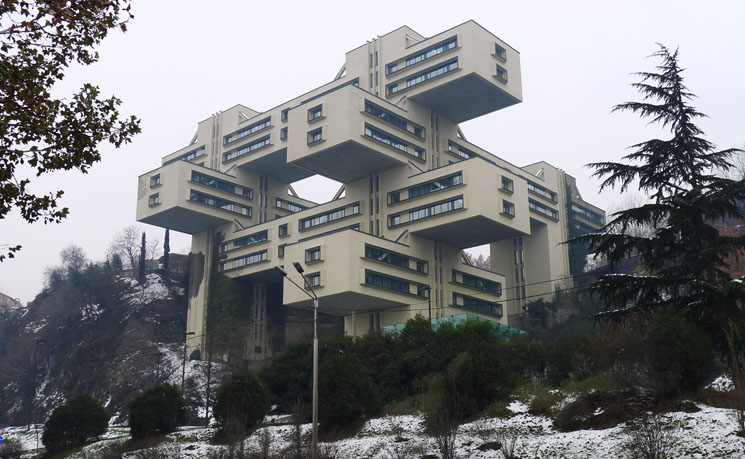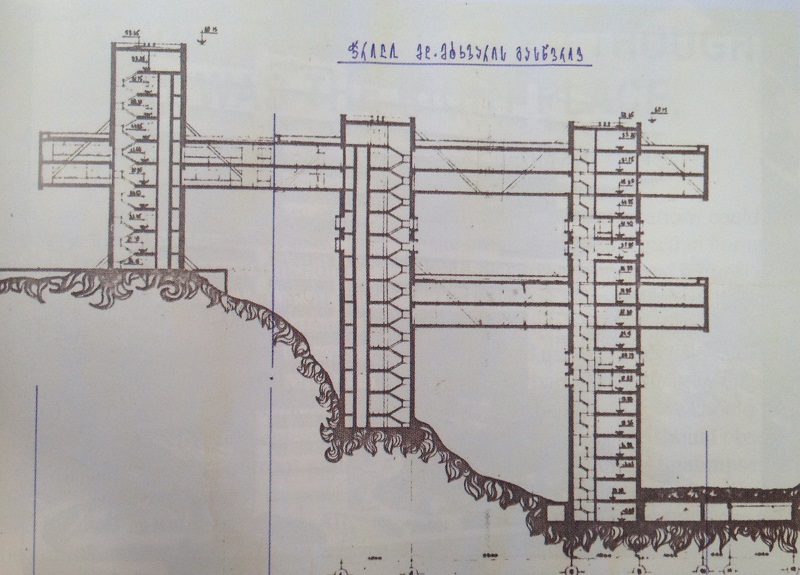Ministry of Transportation Building, Georgia
The former Ministry of Transportation Building in Tbilisi, Georgia, is a striking example of Communist design.
Architects George Chakhava and Zurab Jalaghania designed the building for the Ministry of Highway Construction of the Georgian Soviet Socialist Republic (SSR). Construction was completed in 1975.
The 18-storey building is notable for its unusual design which gives the impression of giant concrete blocks having been piled on top of one another at random. Built on a steep slope, three of the interlocking blocks are oriented on an east-west axis, while two are oriented on a north-south axis. The vertical circulation elements – stairs and lifts – are contained within three cores from which the rest of the structure hangs.
The harsh concrete façade and geometric form was inspired by the theories of the Russian constructivists, as well as the Brutalism movement and the Japanese Metabolists. Following an architectural concept known as the Space City method, parts of the building are raised above the ground, allowing the landscape to grow around and below it.
In 2007, the building was acquired by the Bank of Georgia who converted it into their headquarters, undertaking a major renovation, and installing a new glass cube entrance. In 2007, it was given Immovable Monument status under the National Monuments Act.
[edit] Related articles on Designing Buildings Wiki
- Abandoned movie theatres in Russia.
- Building of the week series.
- CCTV Headquarters.
- Constructivist architecture.
- Fuji TV Building, Tokyo.
- Habitat 67.
- La Grande Arche.
- Manchester Civil Justice Centre.
- Megastructure.
- Metabolism.
- Nakagin Capsule Tower.
- Owen Hatherley - Landscapes of Communism.
- Palace of Culture and Science.
- Robot Building, Bangkok.
- Scottish Parliament Building.
- Spomeniks.
- The Bierpinsel, Berlin.
- Unusual building design of the week.
[edit] External references
Featured articles and news
Grenfell Tower Principal Contractor Award notice
Tower repair and maintenance contractor announced as demolition contractor.
Passivhaus social homes benefit from heat pump service
Sixteen new homes designed and built to achieve Passivhaus constructed in Dumfries & Galloway.
CABE Publishes Results of 2025 Building Control Survey
Concern over lack of understanding of how roles have changed since the introduction of the BSA 2022.
British Architectural Sculpture 1851-1951
A rich heritage of decorative and figurative sculpture. Book review.
A programme to tackle the lack of diversity.
Independent Building Control review panel
Five members of the newly established, Grenfell Tower Inquiry recommended, panel appointed.
Welsh Recharging Electrical Skills Charter progresses
ECA progressing on the ‘asks’ of the Recharging Electrical Skills Charter at the Senedd in Wales.
A brief history from 1890s to 2020s.
CIOB and CORBON combine forces
To elevate professional standards in Nigeria’s construction industry.
Amendment to the GB Energy Bill welcomed by ECA
Move prevents nationally-owned energy company from investing in solar panels produced by modern slavery.
Gregor Harvie argues that AI is state-sanctioned theft of IP.
Heat pumps, vehicle chargers and heating appliances must be sold with smart functionality.
Experimental AI housing target help for councils
Experimental AI could help councils meet housing targets by digitising records.
New-style degrees set for reformed ARB accreditation
Following the ARB Tomorrow's Architects competency outcomes for Architects.
BSRIA Occupant Wellbeing survey BOW
Occupant satisfaction and wellbeing tool inc. physical environment, indoor facilities, functionality and accessibility.
Preserving, waterproofing and decorating buildings.
























